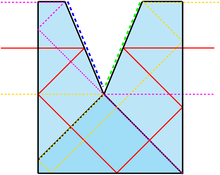Uppendahl prism
An Uppendahl prism is an erecting prism , i.e. a special reflective prism that is used to invert an image (rotation by 180 °). The erecting system consists of three partial prisms made of optical glass with a high refractive index cemented together and is used in both microscopy and binocular technology , for example in the Trinovid series from Leica .
functionality
On its way through the prism, the bundle of rays (red) is first reflected on a surface that is coated with either a metallic or a dielectric coating. The other reflections of the beam take place by means of loss-free total reflection . In order to achieve a complete reversal of the image, a roof edge is ground into the third partial prism (green). Furthermore, the beam leaves the inversion system without any axial offset, which is why the Uppendahl prism is counted among the straight-vision roof prisms.
One advantage of this prism system is that the light beam only passes two transitions between air and glass, which minimizes losses in the form of Fresnel reflections . In order to achieve maximum transmission, the prism is provided with an anti-reflective coating on the incidence and exit surfaces . In addition, a high-quality dielectric mirroring and phase correction coatings are used on both roof surfaces. The relatively strong folding of the beam path in the Uppendahl prism, which is only surpassed by the Schmidt-Pechan prism , supports the construction of compact optical instruments with short overall lengths.
literature
- H. Merlitz: Handheld binoculars: function, performance, selection . Verlag Europa-Lehrmittel Haan-Gruiten 2019, ISBN 978-3-8085-5775-4 .
